If you’re running or facilitating a strategic planning meeting, there are many factors to consider.
It’s much more than just bringing everyone together to have an open discussion — and it doesn’t just happen on its own, either.
There are several steps you can take to ensure that your strategic planning meeting runs smoothly, but it all starts with preparation.
Today, we’ll explore a few ideas to help you hold a successful session, starting with the basics.
Try Miro’s Strategic Planning Template
What is strategic planning?
Strategic planning is the process of analyzing a current situation within your organization and making sure it’s aligned with your specific objectives. If it isn’t, you and your team must develop a plan to “correct the path.”
So, why is strategic planning important?
In short, strategic planning helps you get from where you are today to the future you want. It’s a way of breaking down big, daunting goals into manageable steps that address your current situation and guide your work.
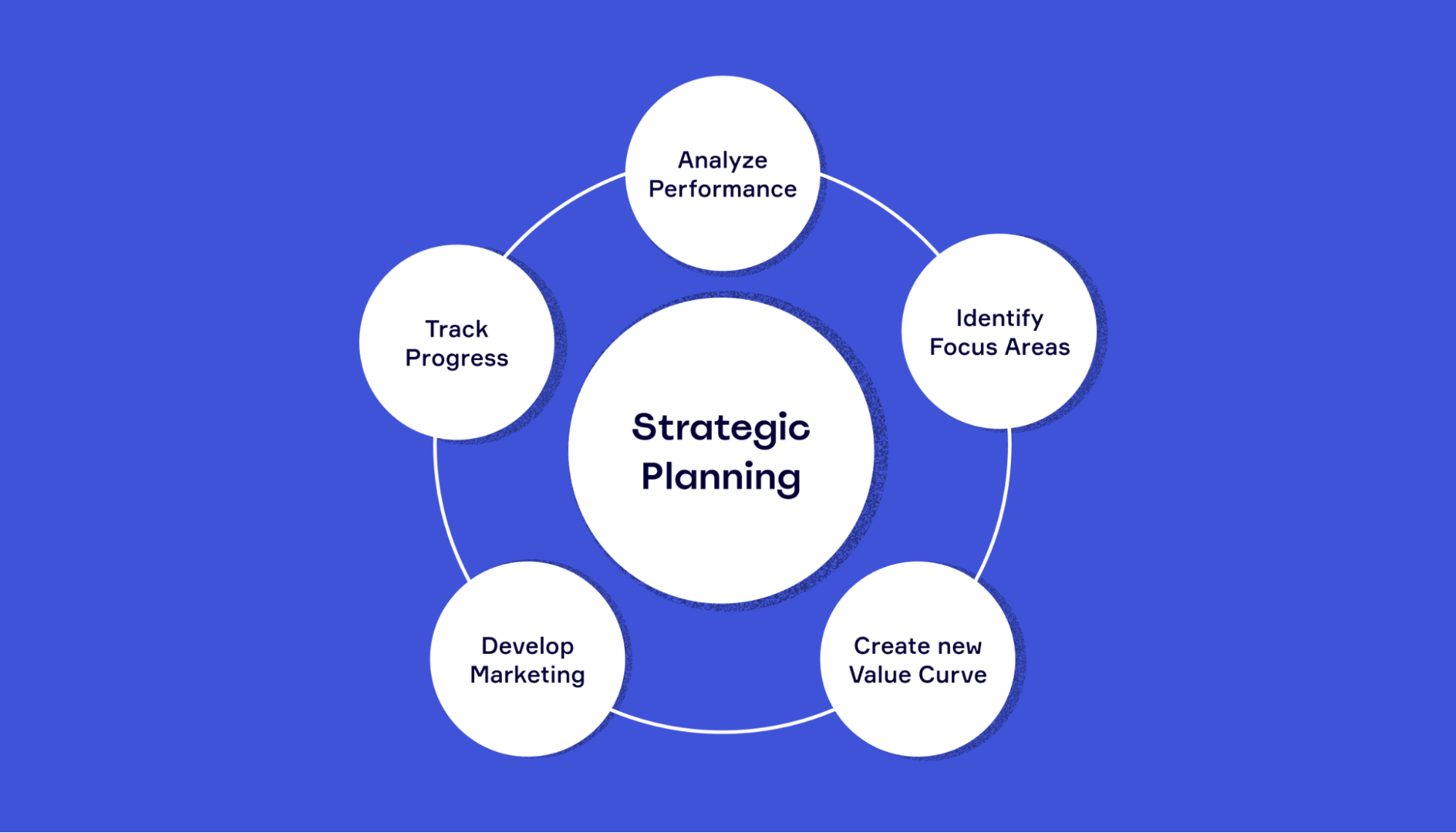
Here’s where strategic planning meetings come into play.
Meetings are the cornerstone of the strategic planning process.
These meetings are typically held by facilitators, but anyone can lead a strategic planning meeting.
We’ll provide you with specific instructions to hold a successful meeting a bit later, but first, let’s answer a crucial question.
What is the purpose of a strategic plan meeting?
Broadly speaking, a facilitator will use meetings to either:
- Gather specific information and feedback from team members, executives, and stakeholders.
- Help team members work together to solve problems, think strategically, and create new ideas to improve the organization.
These meetings aim to provide clarity in decision-making.
This is not a typical meeting where participants spend time reporting out. Strategy planning is all about brainstorming and collaboration.
This way, you can develop solutions to tangible problems in your organization and set the tone and strategic direction for your team.
Who needs to be included?
The best way to ensure that you get all of the most relevant voices in the room is to create an invite list.
Include people from each relevant department, if possible.
This way, you can cover a more complete spectrum of your company’s operations and activities.
You’ll want to include upper management, but don’t stop there.
Bring in members of the sales department, investor relations, human resources, and any other relevant departments or stakeholders.
You might also consider inviting people from outside of the organization who can provide a fresh perspective.
This is particularly useful for organizations that are doing business in a new market or have started offering new products.
Best practices for running a successful strategic planning session
Now that you understand the importance of effective strategic planning meetings, the question becomes, how do you actually hold one?
Let’s cover a few of the best practices:
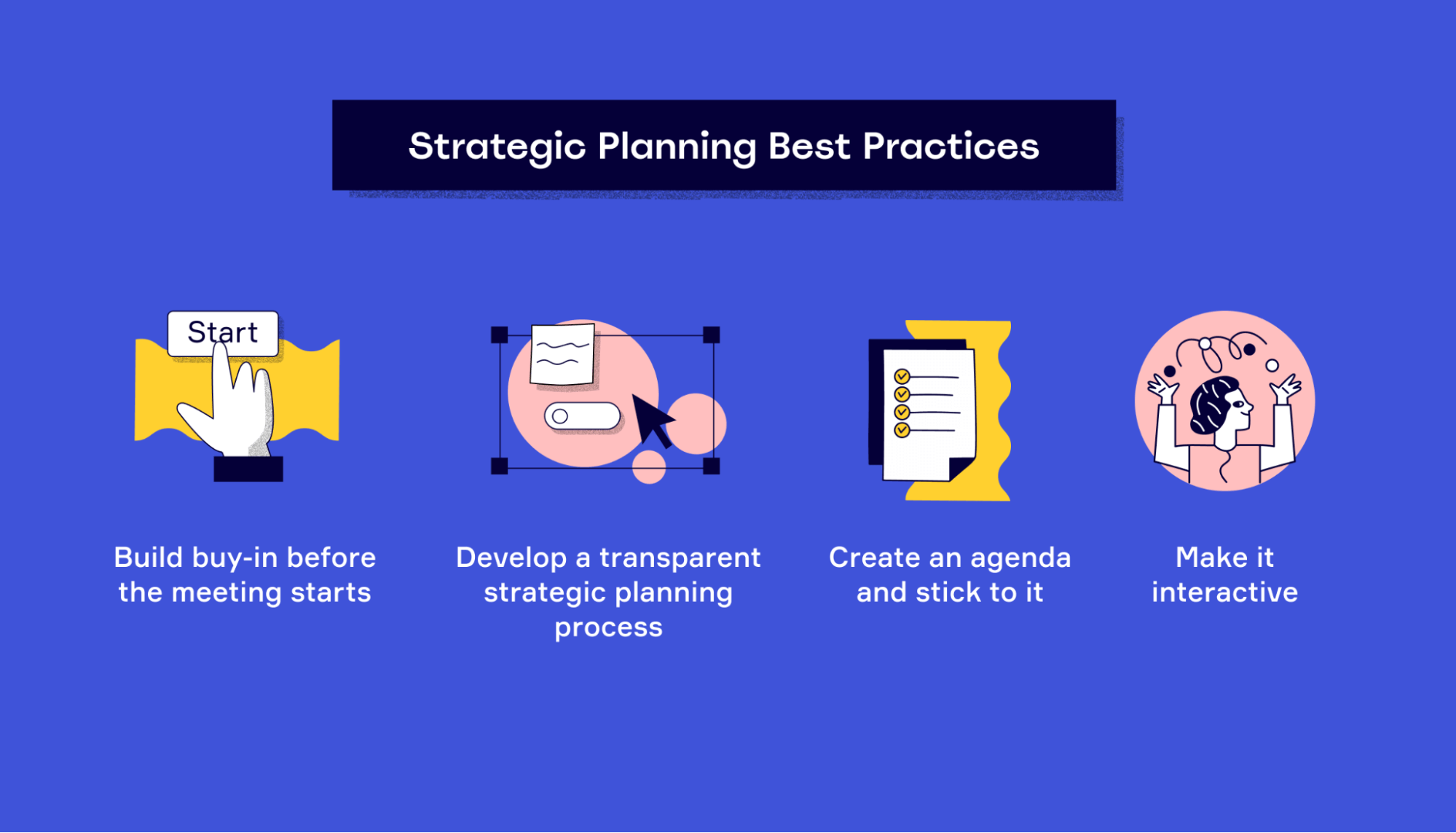
Build buy-in before the meeting starts
First, you’ll want to build buy-in with everyone involved.
Keep what you’re doing top-of-mind, whether that’s through casual conversations or company-wide memos.
In addition, make sure to have a clear agenda prepared, so everyone knows what they can expect out of the meeting. Start by defining the goal, then detail how you’ll get there.
Also, get all the materials you need together in advance.
That may look like coordinating with IT to make sure everyone has access to company software, sending out pertinent documents in advance, or mapping out who will be speaking at the meeting.
Make sure to communicate your expectations clearly so that everyone knows what is expected of them and why.
You’ll want to spend time in your planning stages to keep the tone positive, while at the same time being realistic about what’s possible.
Ultimately, your goal should be to align the team around a shared vision and mission so that you can move forward with a shared perspective.
Now, how can you communicate this agenda?
We suggest you use a centralized space where everyone can see your agenda.
For example, you can use Miro’s Agenda template to create and share your agenda with participants.
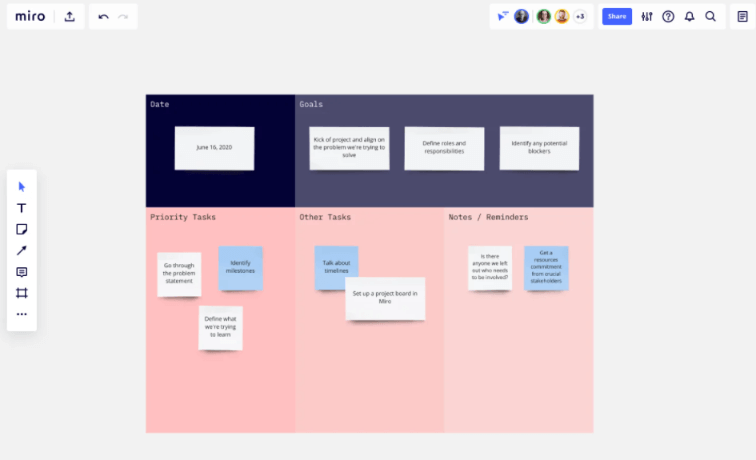
You can also use the template to keep notes during the meeting and add refinements later.
This way, everyone can see what’s been discussed and the next steps for moving forward.
Remember; this should be a collaborative effort, so consider asking for ideas from everyone about what they’d like to see covered.
Just don’t forget to actually take those ideas into consideration.
Develop a transparent strategic planning process
During the strategic process, you’re inviting employees to have meaningful discussions around the company’s vision statement, strategic goals, and strategic objectives.
It’s important to have a roadmap in place for how you will facilitate the process so that employees know what to expect.
Your meeting should be an open, engaging discussion with transparent dialog. During the meeting, everyone should get a turn to talk.
Make sure you have a clear process that allows everyone to participate and feel heard, no matter what their role is.
In the planning stage of a meeting, it’s important to have as much input as possible.
You can involve everyone by holding a virtual brainstorming session with this brainstorming template. Once you create a board, you can invite people to collaborate in real time.
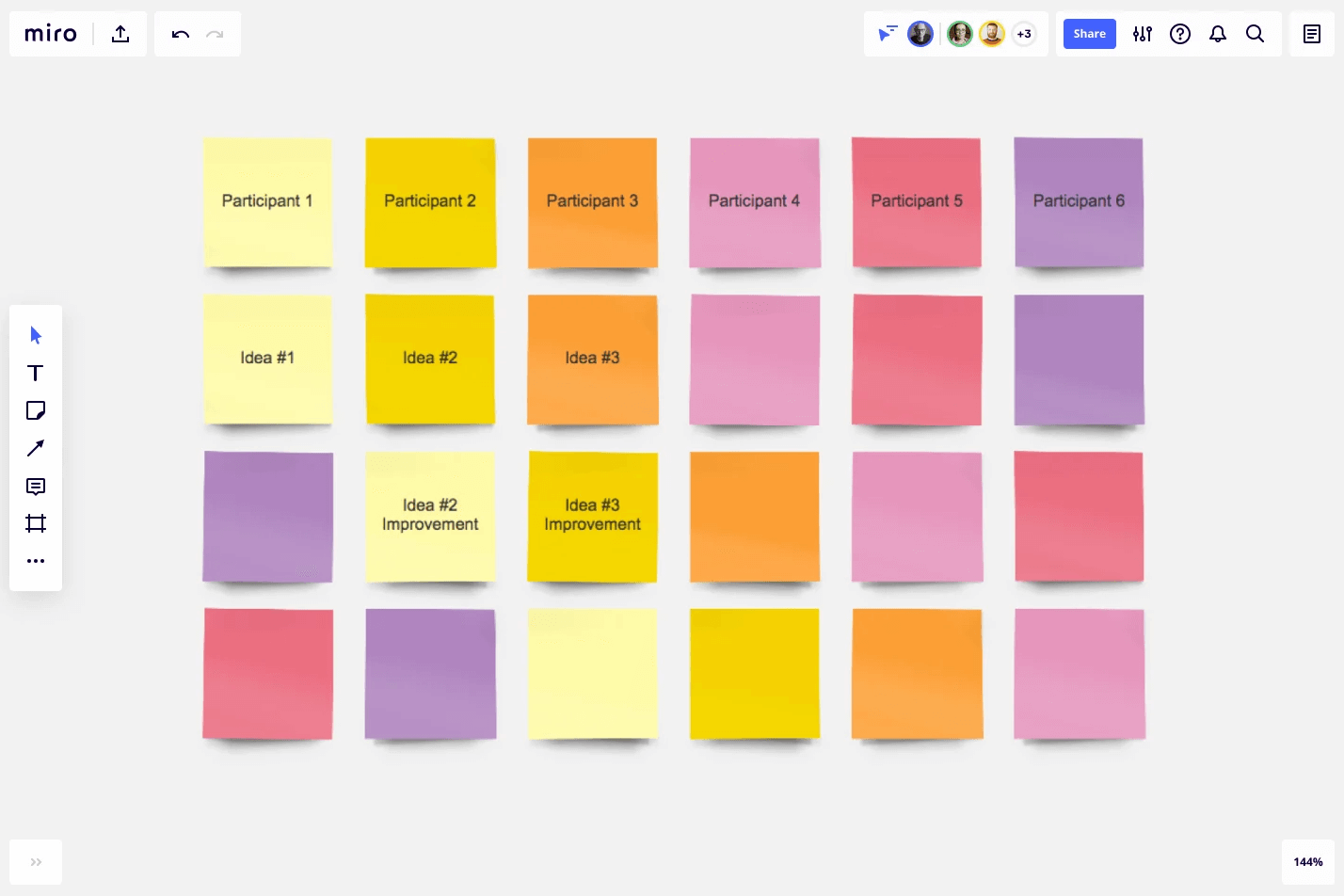
This template helps you create a more engaging and collaborative session while allowing every person on the team to contribute their thoughts.
Create an agenda and stick to it
We all know what happens when an agenda is not set or adhered to.
Creating an agenda for your meeting helps you and your participants stay on track. This agenda should include topics, questions, milestones, and people.
Milestones are the larger topics that will be broken down into smaller questions, and these questions should flow to the ultimate goal of narrowing down your strategic priorities.
You can create milestones by putting together a list of discussion questions that will help your participants get on topic and help you check in with the group.
Your agenda might include an opening discussion, a brainstorming session on ideas, and a closing review of the next steps.
When developing your agenda:
- Keep it short: The last thing you want is your meeting to drag on for no good reason, so try to limit each agenda item to ten minutes or less. The whole meeting should only take an hour or two, at most.
- Be selective: Don’t include too many topics or ideas that will bog down your meeting.
- Create a contingency plan: You never know what might happen during your meeting, so always have a backup plan in case your agenda falls through.
- Plan for breaks: For longer meetings or workshops, set aside at least half an hour to take a break, such as during lunchtime.
Make it interactive
As much as possible, you’ll want to make this a collaborative effort, so it’s important to get everyone involved.
For example, you might want to break the group down into smaller sub-teams to brainstorm opportunities for new product features.
You could also task each group with creating a list of opportunities for particular departments within your company.
The point is that you’ll want to encourage open and honest dialog about challenges your company is facing and, where possible, break down any barriers that might stand in the way of progress.
Make sure to collaboratively create strategy documents, provide regular updates on progress, and discuss strategic issues in real time.
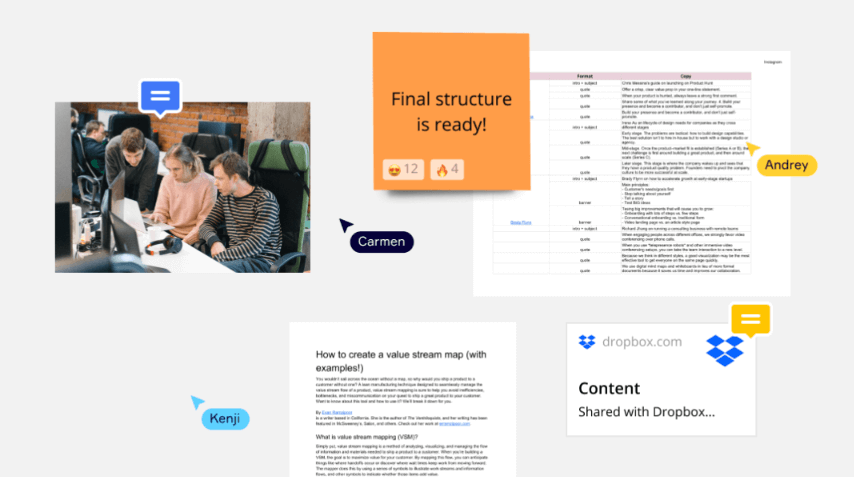
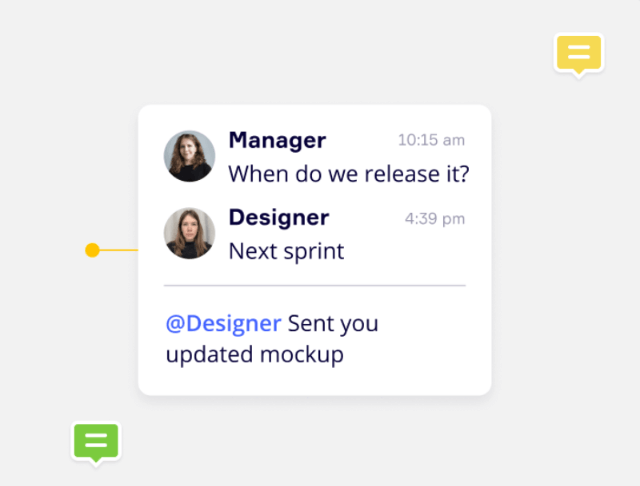
This way, you can work side-by-side to improve your performance, no matter where in the world your team members happen to be.
How to run a strategic planning meeting in 7 steps
To get the most out of each session, you should prepare thoroughly — from the agenda to who you’ll involve and how.
Whether you’re holding a remote, hybrid, or in-person meeting, this process will help you out.
1. Define a clear outcome for the meeting
A strategic planning meeting can go totally off-the-rails if it’s held without a defined objective. That’s why the very first step is to define a clear, tangible goal for the meeting.
For example, your objective might be to better align social media with your marketing strategies.
In this case, your meeting might include a discussion on the purpose of social media, its role in the planning process, and how to better align your social media campaign with your organizational goals.
If your goal is to develop a new product, your meeting might look different.
Consider discussing who the target audience would be and how you can get in front of them. You could also discuss how the product should be positioned in the marketplace and what strategies you’ll use to get it there.
You can also set specific strategic planning meeting themes as part of your objectives, such as business growth or innovation.
The point is to be as specific as possible with your goal. That way, it’s easier for everyone to stay on task and make the right decisions.
2. Break the ice
A strategic planning meeting can be a big undertaking, so it’s important to break the ice by engaging participants in some friendly conversation.
You may want to ask participants what they think of the company’s latest direction or engage them in a fun icebreaker activity. You can also ask them what they think of the new business strategy and how they would implement it.
Or you could ask participants to complete an activity that allows them to interact with one another and develop a better understanding of each other’s unique skills.
For instance, you could assign participants to form teams, and then ask them to create a project plan to solve an issue the company might be experiencing.
You can also break the ice by having participants introduce themselves.
If you’re holding a remote or hybrid meeting, you could have participants discuss what they think in a private online chat room, or you could use an instant messaging program for the same purpose.
Make sure they feel comfortable sharing their thoughts and ideas with each other before starting the main agenda.
The bottom line? The more connected the group is prior to the meeting, the more effective the meeting will be.
3. Set clear expectations
Once you know what you want out of the meeting, the next step is to communicate any expectations of participants, such as things they should prepare in advance of the meeting.
Here are some useful guidelines to keep in mind when you’re setting expectations:
- Provide details: The more detail you provide, the clearer it will be as to what’s required.
- Assign roles: Make sure everyone knows their role and responsibilities within the meeting audience.
- Use timelines: Use timelines to remind everyone of what needs to be completed before the meeting and send reminders if necessary.
- Communicate effectively: Encourage participants to talk with their teams about the fact strategy planning is happening. They may want to set up smaller meetings to gather input for the strategy planning workshop or to share the outputs after the meeting to give employees a chance to ask questions.
4. Set ground rules for behavior
Before the meeting starts, make sure everyone knows the rules.

This is especially important when working with external stakeholders.
For example, you might say something like:
“The goal of this meeting is to develop the strategic plan for the next quarter. We want to minimize distractions, so please don’t check your phone during the meeting.”
Another good idea is to let participants know how they’ll be evaluated. For example, if you’re trying to make progress on a project, you might say something like:
“Let’s try and reach a consensus on the first three points. If we can do that, we’ll consider the meeting a success.”
If you’re dealing with a remote or hybrid team, you should take the time to define online behavior standards. For instance, you could say something like:
“If you have a question, please type it in the chat window. Using outside chat programs is not permitted during the meeting.”
This way, you’ll have everyone invested in the outcome.
5. Identify potential challenges
Before the meeting starts, it’s always good to identify potential areas of conflict that might derail the process.
For example, what would happen if someone had to leave halfway through? Will the meeting continue without them, or will you reconvene once they’re back?
You should also consider how to handle difficult participants. Can you remove a difficult participant from the meeting before they hijack all of your time?
What happens if a disagreement comes up and it’s not resolved?
You should prepare for all these things in advance and have a plan ready if they do happen. For example, consider using a countdown timer for specific agenda items or presentations, so that time is allocated fairly.
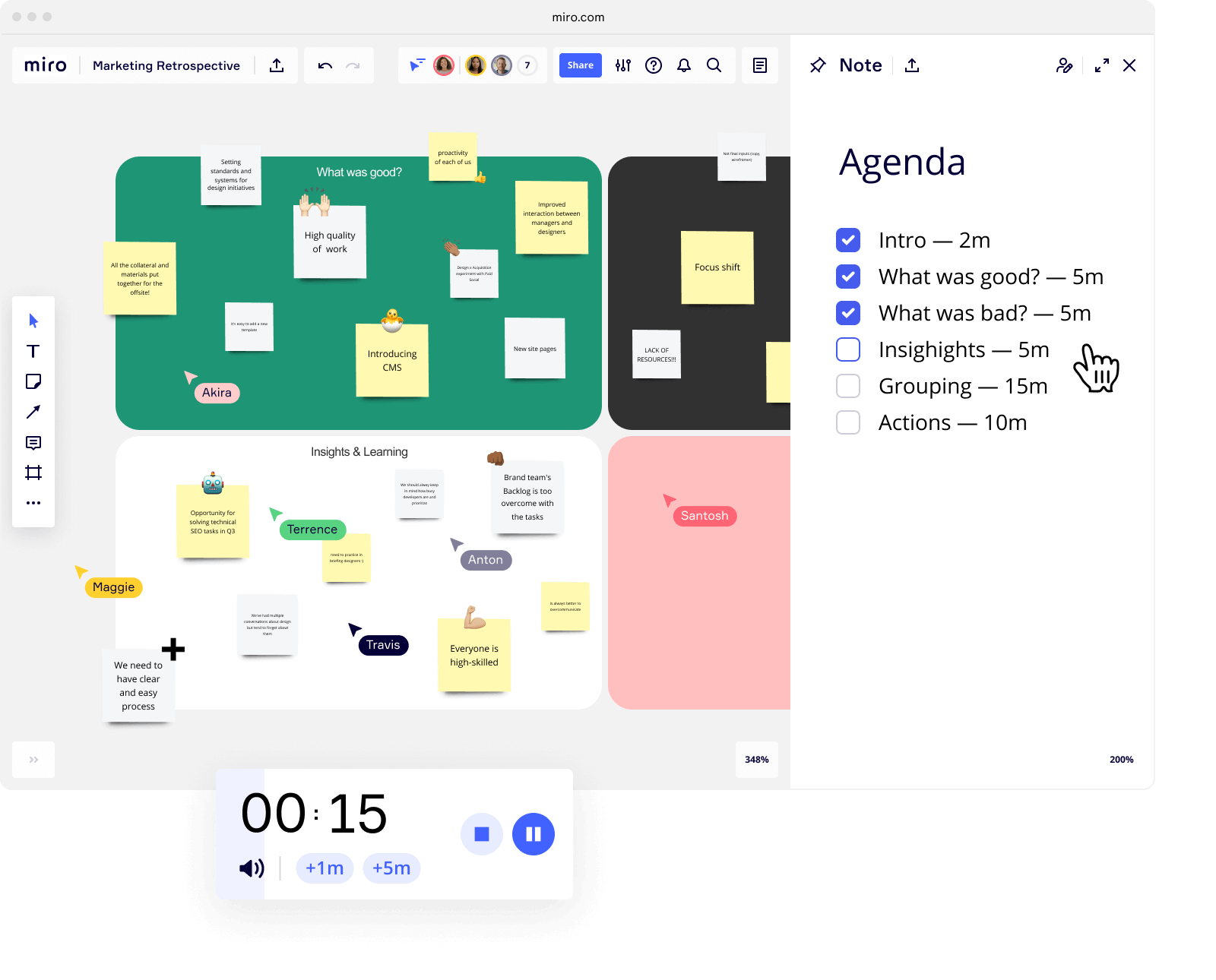
If you identify potential challenges early on, you can keep an eye out for them as the meeting proceeds.
6. Encourage full participation
Remember that you’re asking people to spend time — and sometimes travel — to participate in your meeting.
It’s essential that everyone feels like they have the opportunity to participate. The best way to do this is by mentioning at the beginning of the meeting that you’d like everyone’s input throughout.
Make sure to keep an eye out for people who aren’t speaking up. If it seems like they may have something to contribute, ask them for their thoughts on the topic.
Also, make sure everyone knows that participation is critical. If you need to take a vote on something, remind people what the vote is about and why it matters.
Finally, make sure you’re speaking in terms that everyone in the room can understand. If there are people who are new to the organization, spend a moment explaining any acronyms you use.
This will allow everyone to feel like they can give their input with ease, leading to a more successful meeting.
7. Use visuals and brainstorming tools to communicate ideas
Having everyone on the same page is critical, even if they can’t be in the same room.
Here’s where visuals and collaboration platforms come in handy.
Using collaborative tools, like our brainstorming templates helps you organize work and removes some of the stress of coming up with ideas on the spot.
It also encourages people to provide input and makes them feel like they have a stake in the outcome.
For instance, you can use Miro’s Reverse Brainstorming template to come up with innovative ideas and display them in real time. You can save the meeting content on the board too, so you can send it to participants after the meeting.
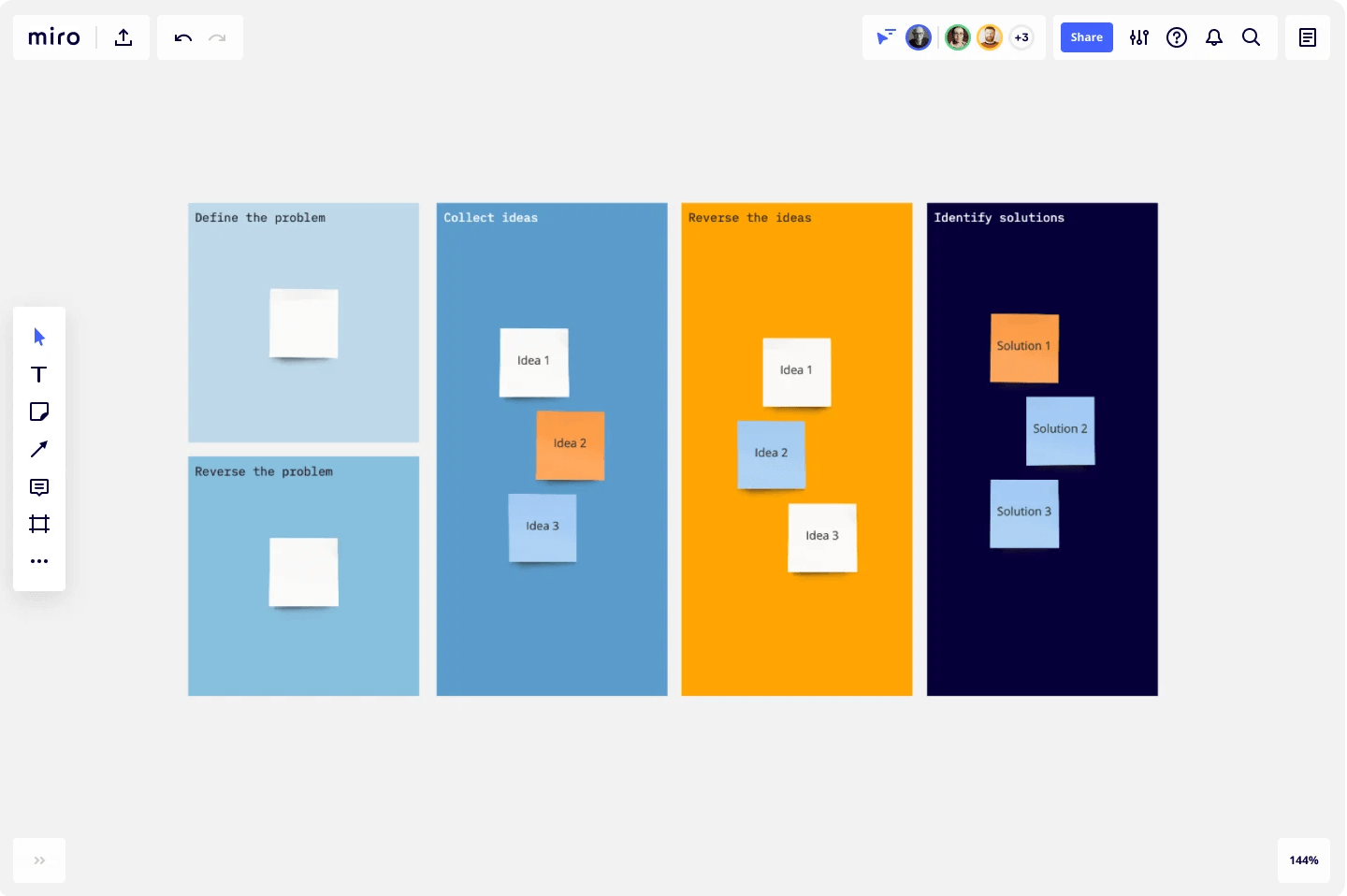
This can be especially useful if you have multiple participants in different locations involved at the same time. They may not be able to physically attend the meeting, but they can still provide valuable input.
Also, we provide you with a fully customizable strategic plan template.
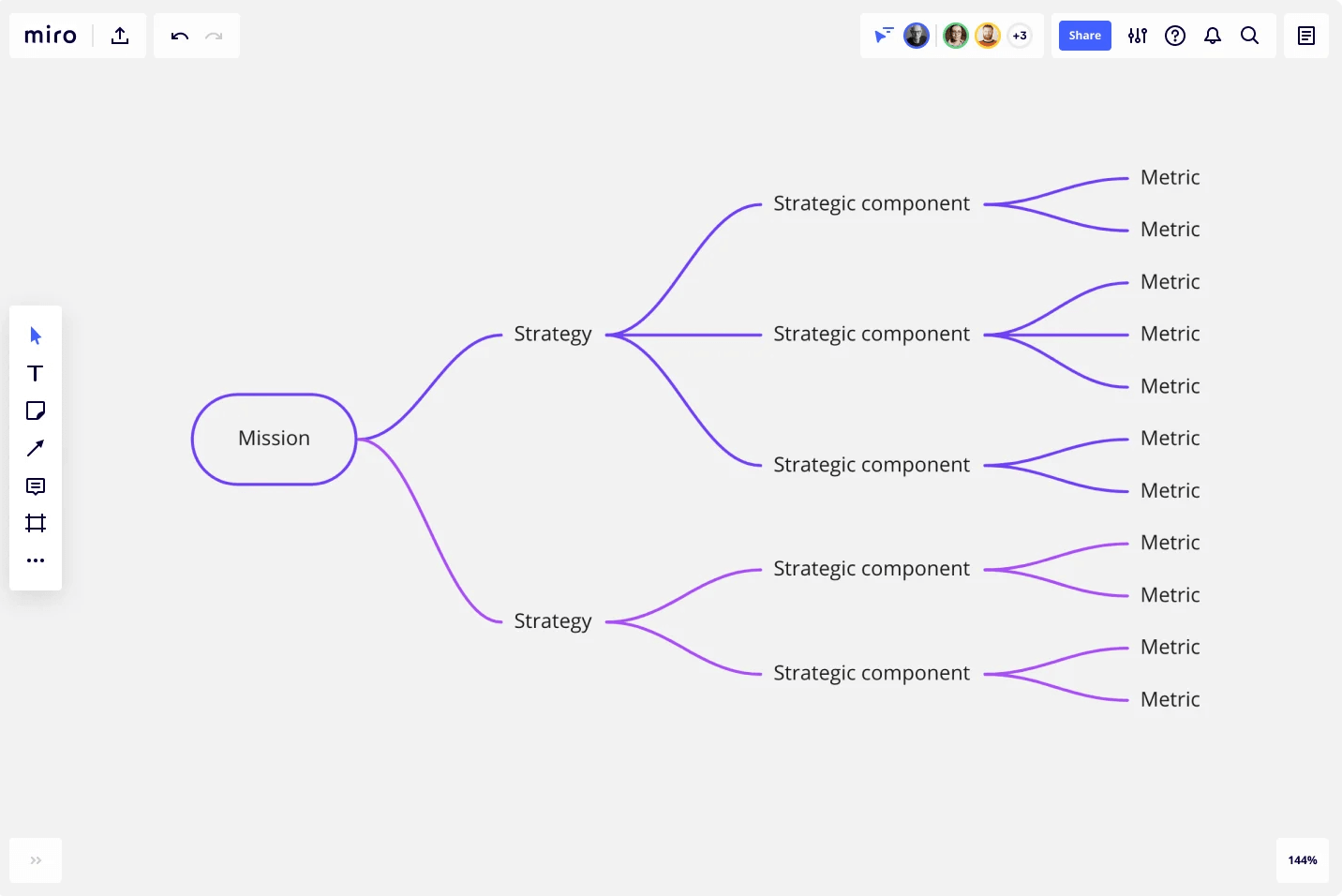
You can adapt this template to fit your exact business needs and standardize your meetings with ease.
Sample agenda for a strategic planning meeting
You need to make sure your strategic planning meeting agenda is detailed and thorough enough to keep you on task.
Start with an overview of what you’ll be discussing, then move into individual department updates. This is where you highlight progress against targets.
Finally, spend some time outlining your organizational goals moving forward and, of course, always leave time for questions.
To help you better understand what a strategy planning session might look like in the real world, here’s a sample agenda:
- 10am–11am: Welcome and meeting goals
- 11am–12pm: Leadership team updates
- 12pm–1pm: Department updates
- 1pm–2pm: Lunch break
- 2pm–3pm: Analyze challenges and problems
- 3pm–4pm: Ideate solutions
- 4pm–5pm: Discuss and gain consensus on solutions and goals
- 5pm–6pm: Assign tasks and responsibilities for strategy execution
- 6pm–7pm: Q&A
It all comes down to solid preparation and visuals
The best way to ensure your meeting runs smoothly and effectively is to prepare it with anticipation. By creating a clear agenda, you’re able to get the most out of your session.
Also, the use of visuals and brainstorming tools helps you collaborate with your team and communicate your critical points more effectively.
You can hold your planning meetings in a more visual way by creating a board and sharing with your team.
Also, you can use the strategic planning meeting template to get started with fewer headaches.



